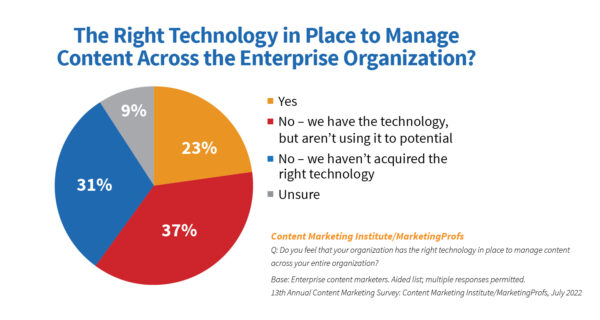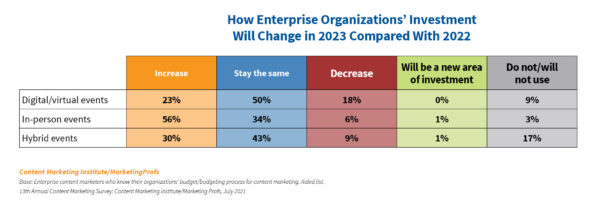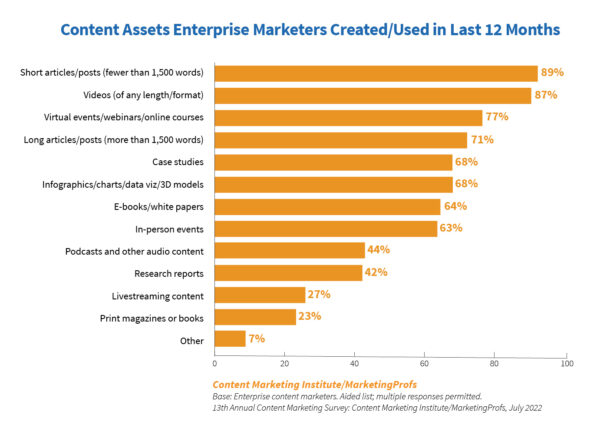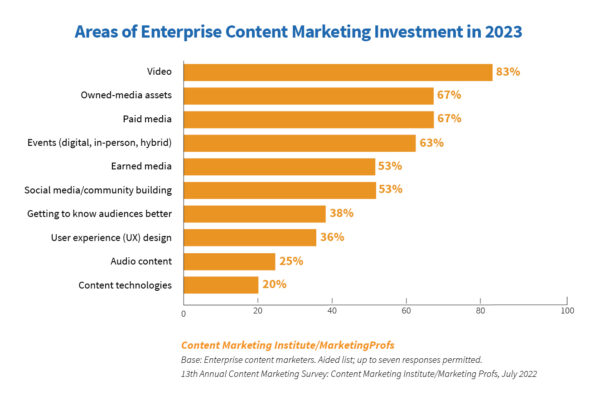MARKETING
Enterprise Content Marketing Research 2023

Navigating work in a large organization comes with unique challenges, especially in times of change.
But one thing remains constant – communication endures as one of the thorniest issues.
So it’s no surprise in our newly released Enterprise Content Marketing: Benchmarks, Budgets, and Trends – Insights for 2023, well over half (64%) of enterprise content markers say communicating among internal teams/silos is a challenge.
That’s one of the findings from the analysis of the 278 enterprise marketers (those working in companies with at least 1,000 employees) who completed our annual content marketing survey.
64% of enterprise #content marketers say communicating among teams/silos is a challenge, according to @CMIContent #research via @EditorStahl. Click To Tweet
Here’s a snapshot of the content marketing practices, challenges, opportunities, and 2023 plans they shared with us.
Common challenges of enterprise content marketers
Close in popularity to the internal communication challenge is creating content that appeals to different stages of the journey (62%). Among the other most frequently cited challenges of enterprise marketers: technology integration (41%), accessing subject matter experts to create content (38%), achieving consistency with messaging (37%), developing consistency with measurement (37%), and differentiating products and services from the competition’s (37%). Interestingly, only 24% say continuing to make a business case for content marketing is a challenge (and 1% say they have no challenges.)
In their open-ended (qualitative) responses, many enterprise content marketers told us they want to see content marketing centralized within their organization. Even more expressed a desire to see silos torn down.
Lynn Heidmann, senior director of content marketing at Dataiku, found a solution at her enterprise. Though the central content marketing team owns content creation for global marketing campaigns, it isn’t the only team producing external-facing content. Other teams create all content for partners, customers, and prospects.
To maintain a consistent content approach and keep everyone up to date, the central content marketing team shares “lots of best practices [things like central messaging documentation, style guides, etc.] and offer(s) up our time for reviewing other teams’ work, involving them in our workflows where we can try and streamline as much as possible.”
Technology is an issue
Tools and technology can be an especially fraught issue in enterprises. Buying decisions sometimes takes ages, and solutions that work well for one team might not suit another.
In a new question on the annual survey, we asked marketers if they thought their organization had the right technology to manage content across the organization. Only 23% say yes. Nearly a third (31%) say no. Even more (37%) say they have the technology but aren’t using it to its potential.

Having and using the right technology sets top-performing content marketers apart. Of those who think their organization is extremely or very successful with content marketing, 38% say they have the right technology to manage content across the organization compared to 23% of all enterprise marketers.
Enterprise marketers who report being extremely or very successful are more likely than all marketers to have the right tech to manage #content across the organization, according to @CMIContent #research via @EditorStahl. Click To Tweet
That makes sense to CMI’s chief strategy advisor Robert Rose who recently said, “Any marketing technology worth purchasing involves implementation, training, user learning curve time, and ongoing administration.”
Is tech a solution to all your content woe? No. Does that mean it’s not worth addressing? Of course not. The first step, Robert advises, is to get your processes in order before shopping for the tech to help them.
“I’ve been advising clients and colleagues to worry less about which new technology will be a must-have for 2023,” he writes. “Instead, work on developing the muscle to evolve content activities into repeatable processes.”
(Read more of Robert’s advice in this Rose-Colored Glasses column, Your 2023 Planning Shouldn’t Be All About That Tech.)
More differentiators of top performers
Top-performing enterprise marketers also stand apart from their peers by always/frequently making their content different. They craft content based on stages of the buyer’s journey (72% vs. 47%) and prioritize the audience’s informational needs over their organization’s (81% vs. 61%).
Eighty percent of the top performers say they always/frequently differentiate their content from the competition compared to 53% of all enterprise marketers who say the same.
How do they do it? Well, the same ways are most popular among the top performers and all marketers: producing better quality content (86% of top performers, 85% of all marketers) and covering topics/stories that their competitors don’t (71% for top performers and all marketers).
But the top performers are more likely to do these things than all marketers:
- Produce more content (41% of top performers vs. 31% of all marketers)
- Do a better job distributing content (38% vs. 29%)
- Promote actively the content they publish (58% vs. 53%)
Jeff Revilla, digital marketing director for Smail Auto Group, manages all content operations for 10 franchises. He says his organization differentiates its content by taking the customers on journeys about what they’re most interested in – the vehicles’ features.
“Most of the content in automotive centers around the dealer screaming, ‘We have inventory’ or ‘Look at these deals!’ We took a different approach. Instead of talking about us, we created a series of videos that take the customer through a journey of the vehicle. We only mention our name in the intro, never talk about price, and only focus on the features that a car owner would care about. Once we figured out that formula, our YouTube growth was exponential.” Since 2008, Smail Auto Group’s YouTube channel has had almost 2.5 million views.
In-person events are back
This trend doesn’t surprise me at all – in-person events are back. We’ve seen it and participated in it.
Sixty-three percent of enterprise marketers report using in-person events this year – that’s 2.5 times more than the previous year’s survey.
Use of in-person events by enterprise marketers jumped 2.5 times this year over last year, according to @CMIContent #research via @EditorStahl. Click To Tweet
In addition, 56% expect their organization’s in-person event investment to increase in 2023 compared with their 2022 budget.
Having the right content to support these in-person events can extend the audience’s experience and the enterprise’s investment.
Dataiku’s Lynn Heidmann shares that her team has a hand in shaping the narrative of the brand’s event content. “A memorable, well-crafted message on stage is what people come to events for, so that’s what works best, and we try to support that,” she says.
And make sure to capitalize on the events for future content. “We’ve had great success with on-site surveys, which are a great way to collect data that you can reuse in later content pieces,” Lynn says.
Video investment continues to rise
Another finding everyone (enterprise or not, content marketer or consumer) already sees? The use of video.
Among enterprise content marketers, the use of video increased to 87% from 79% the previous year, making it the second most often used type of content. Now it’s second only to short articles/posts (89%).
Among the other content assets used in the last 12 months:
- Virtual events/webinars/online courses (77%)
- Long articles/posts – more than 1,500 words (71%)
- Case studies (68%)
- Infographics/charts/dataviz/3D models (68%)
- E-books/white papers (64%)
- In-person events (63%)
- Podcasts and other audio content (44%)
- Research reports (42%)
- Livestreaming content (27%)
- Print magazines or books (23%)
Video also tops the list of predicted content marketing investments in 2023, with 83% expecting to spend money on video for their enterprises.
Among the other popular categories for investment:
- Owned-media assets (67%)
- Paid media (67%)
- Events – digital, in-person, hybrid (63%)
- Earned media (53%)
- Social media/community building (53%)
- Getting to know audiences better (38%)
- User experience design (36%)
- Audio content (25%)
- Content technologies (20%)
Video’s place at the top of the investment list is good news because it’s one of the top five content assets that produced the best results for enterprise marketers in the last 12 months.
Will 2023 be a bumpy ride?
Your team may grow or shrink. Your budget may rise or fall. Your content may succeed or struggle. To manage those surprising and expected events, use these and the rest of the findings to get your bearings for the rest of 2023.
Amy Fair, content marketing manager at SpyCloud, sums up the 2023 vibe for enterprise and other marketers beautifully: “I would encourage folks to continue to nurture their networks to ensure they have a robust support system at all times … You never know when you could be impacted, and making sure you have built solid relationships with colleagues who are there for you can be a lifesaver, both literally and figuratively.”
HANDPICKED RELATED CONTENT:
Cover image by Joseph Kalinowski/Content Marketing Institute
MARKETING
A Recap of Everything Marketers & Advertisers Need to Know

When rumors started swirling about Twitter changing its name to X, I couldn’t believe it at first. But then, in July 2023, as I searched for my favorite blue icon on the phone, I found a black icon instead. It had actually happened!
MARKETING
The key to correcting the C-suite trust deficit

Take a moment to search “CMO tenure” and you’ll find a wide variety of content discussing the short tenure of CMOs and how it’s among the shortest of roles in the C-suite. If you dive deeper, you’ll find that CEOs don’t seem to trust CMOs.
Boathouse’s CMO Insights study (registration required) noted several sobering conclusions:
- 34% of CEOs have great confidence in their CMOs.
- 32% of CEOs trust their CMOs.
- 56% of CEOs believe their CMO supports their long-term vision.
- And only 10% of CEOs believe their CMO puts the CEO’s needs before their own.
If these statistics also apply to the CMO’s entire organization, then it’s clear we have a trust problem with marketing leadership.
If you haven’t read Patrick Lencioni’s “The Five Dysfunctions of a Team,” I consider it required reading for anyone in any leadership role. In his book, Lencioni builds a pyramid of dysfunctions that need to be addressed for a team to succeed. The foundational dysfunction — with which one cannot build a successful team — is “absence of trust.” We see it at scale with marketing organizations today.
Introducing objectivity through data
In “Hamlet,” Shakespeare writes, “There is nothing either good or bad, but thinking makes it so.” Each organization that makes up a company looks at the company from a different perspective. What marketing sees as positive, finance may see as negative. But who’s right? No one.
Usually, there is no objectivity because leadership comes up with an idea and we execute it. It’s like the fashion proverb “Beauty is in the eye of the beholder.” Unfortunately, we’re going to struggle to run a profitable organization if it’s run like a fashion show.
Therefore, we need to introduce objectivity to how we work. Leadership needs to come together to agree on goals that align with the goals of the broader organization. One element of this conversation should be an acknowledgment that this is turning a ship.
Often leaders — especially those without marketing backgrounds — are likely to expect instant gratification. It’s going to take time to turn the ship and you and your team would do well to set reasonable expectations right away.
Dig deeper: KPIs that connect: 5 metrics for marketing, sales and product alignment
Aligning goals and metrics across the organization
With goals in hand, we need to assign metrics to their progress and agree on the source(s) of truth. Once these objective measures are in place, perspective doesn’t matter. 2 + 2 = 4 regardless of whether you’re in HR or accounting.
Every public road has a speed limit and whether you’re in compliance with it has nothing to do with your perspective. If you’re above it, you’re wrong and subject to penalties. Referring to the fashion example, it’s not a fashion show where some people like a dress and others don’t.
By using data to objectively measure marketing’s progress within the organization and having the rest of the leadership buy into the strategy, we build trust through objectivity. Maybe the CEO would not have chosen the campaign the marketing team chose.
But if it was agreed that a >1 ROAS is how we measure a successful campaign, it can’t be argued that the campaign was unsuccessful if the ROAS was >1. In this example, the campaign was an objective success even if the CEO’s subjective opinion was negative.
Data-driven campaign planning
Within the marketing organization, campaigns should always be developed with measurement top of mind. Through analysis, we can determine what channels, creative, audiences and tactics will be most successful for a given campaign.
Being able to tell the leadership team that campaigns are chosen based on their ability to deliver measured results across metrics aligned to cross-departmental goals is a powerful message. It further builds trust and confidence that marketing isn’t run based on the CMO’s subjective opinions or gut decisions. Rather, it’s a collaborative, data-driven process.
For this to be successful, though, it can’t just be for show, where we make a gut decision and direct an analyst to go find data to back up our approach. This would be analytics theater, which is a perversion of the data. Instead, tell the analyst what you think you want to do and ask them to assess it.
For the rest of the organization’s leadership, ask questions when the marketing team presents a campaign. Find out how they came up with the strategy and expect to hear a lot about data — especially the metrics you all agreed would support the company’s overarching goals.
Dig deeper: 5 failure points of a marketing measurement plan — and how to fix them
Data literacy: Building credibility through transparency
Building trust doesn’t happen overnight, but a sustained practice of using data to drive marketing leadership’s decisions will build trust if the metrics ladder up to the organizational goals and all of leadership is bought into the measurement plan.
Over time, this trust will translate into longer tenure and more successful teams through building the infrastructure needed to tackle Lencioni’s five dysfunctions.
Opinions expressed in this article are those of the guest author and not necessarily MarTech. Staff authors are listed here.
MARKETING
How Tagging Strategies Transform Marketing Campaigns


As a marketer, I understand how today’s marketing campaigns face fierce competition. With so much content and ads competing for eyeballs, creating campaigns that stand out is no easy task.
That’s where strategies like tagging come in.
It helps you categorize and optimize your marketing efforts. It also helps your campaigns cut through the noise and reach the right audience.
To help you out, I’ve compiled nine ways brands use a tagging strategy to create an impactful marketing campaign.
Let’s get to it.
How Brands Use a Tagging Strategy
Tagging involves using keywords or labels to categorize and organize content, products, or customer data. You attach tags to specific items or information to make searching, sorting, and analyzing data easier.
There are various types of tags, including meta tags, analytics tags, image tags, hashtags, blog tags, and more.
So, how do brands use a tagging strategy to make their marketing campaigns stand out?
Improve Social Media Engagement
With over 5 billion users, social media provides an easy way to connect with your audience, build relationships, and promote your offerings.


Use a tagging strategy to boost social media interactions. Consistently use hashtags that align with current trends and topics. This encourages people to interact with your content and boosts content visibility.
You can also use tags to monitor brand mentions of your products or your industry. This allows you to engage with your audience promptly.
Consider virtual social media assistants to streamline your tagging strategy. These AI-driven tools can suggest relevant hashtags, track mentions, and automate responses. Implementing them can save time and resources while ensuring consistent engagement across your socials.
Build a Personal Brand on LinkedIn
LinkedIn is the world’s largest professional networking platform, with over 1 billion members across 200 nations. It offers excellent opportunities for individuals and businesses to build and nurture their brands.


However, simply creating a professional profile isn’t enough to build a personal brand on LinkedIn.
Use various tags to increase your visibility, establish thought leadership, showcase expertise, and attract the right connections. For instance, use skill tags to showcase your expertise and industry tags to attract connections and opportunities within your industry. Use certification tags to help showcase your expertise and credibility to potential employers or clients.
Facilitate Customer Segmentation and Personalization
Personalization matters—more so in today’s data-driven world. In fact, 65% of consumers expect your brand to adapt to their changing preferences and needs.
To meet this expectation, consider using a tagging strategy.
Segment your customers based on shared characteristics, such as demographics, interests, purchase history, cart abandonment, and behavior.
Here’s a summary of the steps to customer segmentation.


With your customer segments ready, use tags to tailor your marketing messages and offerings to specific segments. Imagine sending targeted email campaigns based on what your customers need. That’s the power of segmentation and tagging in action!
Enhance SEO and Content Discoverability
Tagging content can have a profound impact on search engine optimization (SEO) and content discoverability. When users search for specific topics or products, well-tagged content is more likely to appear in search results, driving organic traffic to your website.
Additionally, tags can help you analyze the most popular topics with your readers. Then, the results of this analysis can help you adjust your content strategies accordingly.
And get this— certain AI tools can help analyze your content and suggest relevant tags and keywords. Using these tools in addition to a tagging strategy can help optimize your SEO strategies and boost content discoverability.
Partner with the Right Influencers
Influencer marketing has become a go-to marketing approach for modern brands. Recent stats show that 85% of marketers and business owners believe influencer marketing is an effective marketing strategy.
But how do you find the perfect influencer for your campaign?
Utilize tags to identify influencers who are relevant to your niche. Beyond this, find influencers who align with your brand values and target audience.
Additionally, look for influencers who use hashtags that are relevant to your campaigns. For instance, fashion influencer Chiara Ferragni uses #adv (advertising) and #ghd (good hair day) hashtags in this campaign.


Monitor industry-specific hashtags and mentions to discover influential voices and build profitable relationships with them.
Track Hashtag Performance
Tracking your hashtag performance helps you understand your campaigns’ engagement, reach, and effectiveness.
To achieve this goal, assign special hashtags to each marketing project. This helps you see which hashtags generate the most engagement and reach, enabling you to refine your tagging strategy.
Here’s an example of a hashtag performance report for the #SuperBowl2024.


This curated list of hashtag generators by Attrock discusses the top tools for your consideration. You can analyze each and choose the one that best fits your needs.
Categorize Content Accordingly
The human attention span is shrinking. The last thing you want is for your audience to have difficulty in finding or navigating your content, get frustrated, and bounce.


Untagged content can be difficult to navigate and manage. As any marketer knows, content is important in digital marketing campaigns.
To categorize your content, identify the main categories by topics, themes, campaigns, target audiences, or product lines. Then, assign relevant tags based on the categories you’ve identified. After that, implement a consistent tagging strategy for existing and new content.
Organizing your content using tags can also help streamline your content management workflow. Most importantly, readers can easily find the content they’re looking for, thereby boosting overall user experience, engagement, and conversions.
Boost Your Email Marketing Strategy
Email marketing remains a powerful marketing tool in today’s digital world. It’s also another area where brands use a tagging strategy to directly reach their target audience.
Use tags to segment your email list and personalize your marketing messages. Then, you can send targeted emails based on factors like purchase history, interests, and demographics.
Personalization can significantly improve open rates, CTRs, and overall engagement and conversion rates. It’s a simple yet impactful strategy to make your email marketing strategy more effective.
Plus, you can use tags to track how well your emails perform with each group. This helps you understand what content resonates best with your audience and provides insight on how to improve your emails going forward.
Enhance Analytics and Reporting
Every marketer appreciates the immense value of data. For brands using tagging strategies, tags are powerful tools for gathering valuable data.
Analyze how users interact with your tagged content. See which tags generate the most clicks, shares, conversions, and other forms of engagement. Gain insight into audience preferences and campaign effectiveness.
This granular data about your marketing efforts allow you to make data-driven decisions, allocate resources effectively, and refine your marketing strategies.
Final Thoughts
There isn’t a single correct way for brands to use a tagging strategy in marketing. You can use a tagging strategy however you see fit. However, the bottom line is that this strategy offers you a simple yet powerful way to create attention-grabbing and unique marketing campaigns.
Fortunately, tagging strategies are useful across various marketing initiatives, from social media and email marketing to SEO and more.
So, if you’re ready to elevate your marketing campaign, build a strong brand presence, and stand out among the competition, consider employing effective tagging strategies today.
-
SEARCHENGINES7 days ago
Daily Search Forum Recap: April 29, 2024
-
SEARCHENGINES6 days ago
Daily Search Forum Recap: April 30, 2024
-

 MARKETING6 days ago
MARKETING6 days agoHow To Develop a Great Creative Brief and Get On-Target Content
-

 SEO7 days ago
SEO7 days agoGoogle’s John Mueller On Website Recovery After Core Updates
-

 WORDPRESS6 days ago
WORDPRESS6 days ago13 Best Fun WordPress Plugins You’re Missing Out On
-

 SEO5 days ago
SEO5 days agoWhy Big Companies Make Bad Content
-

 SEO5 days ago
SEO5 days agoHow To Drive Pipeline With A Silo-Free Strategy
-

 SEO6 days ago
SEO6 days agoOpenAI To Show Content & Links In Response To Queries


 Click to enlarge
Click to enlarge Click to enlarge
Click to enlarge Click to enlarge
Click to enlarge Click to enlarge
Click to enlarge Click to enlarge
Click to enlarge














You must be logged in to post a comment Login